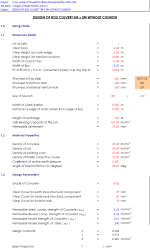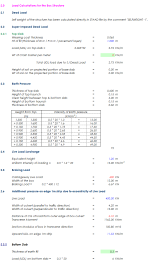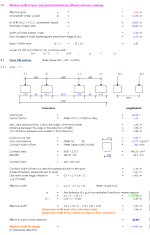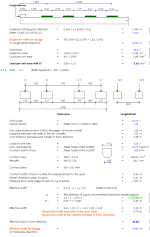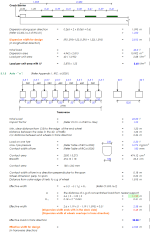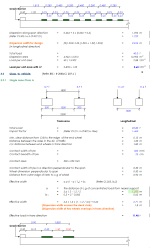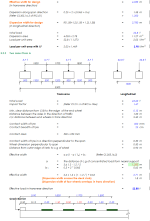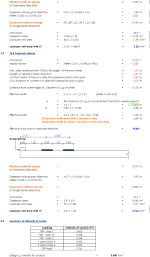Limit State Box Culvert Design IRC:6-1966
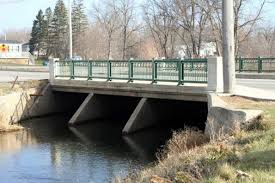
Description
Standard IRC:6-1966
1.0 Design Data
1.1 Dimension Detail
No of cells
Clear Span
Clear Height (at outer edge)
Clear Height (at median location)
Width of road at top
Width of Box
Ht of fill (W.C / P.C.C / pavement layers) over the top slab
Thickness of top slab
Thickness of bottom slab
Thickness of external vertical wall
Size of haunch
Width of Crash barrier
Distance of edge of crash barrier from edge of box
Height of surcharge
Safe Bearing Capacity of the soil
Permissible Settlement
1.2 Material Properties
Density of concrete
Density of soil
Density of wearing coat
Density of Profile corrective course
Coefficient of active earth pressure
Angle of internal friction (in degree)
1.3 Design Parameters
Grade of Concrete
Clear Cover for earth face structural component
Clear Cover for inside face structural component
Clear Cover for bottom slab
Permissible direct comp. strength of Concrete (scc)
Permissible flexural comp. strength of Concrete (scb)
Permissible tensile strength of Concrete ( sct )
Permissible tensile strength of Steel ( sst )
Design Costants:
Base Projection
2.0 Load Calculations for the Box Structure
2.1 Dead Load
Self weight of the structure has been calculated directly in STAAD file by the comment 'SELFWEIGHT -1'.
2.2 Super Imposed Dead Load
2.2.1 Top Slab
Wearing coat thickness
Ht of fill (Thickness of W.C / P.C.C / pavement layers)
Load (UDL) on top slab = 0.065*22
Wt of Crash barrier per meter
Total UDL load due to S.I Dead Load
Height of soil on projected portion of base slab
Wt of soil on the projected portion of base slab
2.3 Earth Pressure
Thickness of top slab
Height of top haunch
Clear height between top & bottom slab
Height of bottom haunch
Thickness of bottom slab
2.4 Live Load Surcharge
Equivalent height
Uniform Intensity of loading = 0.5 1.2 20
2.5 Braking Load
Carriageway Live Load
Width of the box
Braking Load = 0.2 * 400 / 12
2.6 Additional pressure on edge 1m strip due to eccentricity of Live Load
Live Load
Width of culvert (parallel to traffic direction)
Width of culvert (perpendicular to traffic direction)
Distance of CG of load from outer edge of box culvert
Transverse Moment
Section Modulus of box in transverse direction
Upward UDL on edge 1m strip
2.2.2 Bottom Slab
Thickness of earth fill
Load (UDL) on bottom slab = 0.3 * 20
Calculation Reference
Limit State Design
Box Culvert Design
IRC:6-1966
Limit State Box Culvert Design IRC:6-1966 is a code of practice developed by the Indian Roads Congress (IRC) for the design of box culverts. Box culverts are precast concrete or masonry structures used for the passage of water under roads, railways, and other transportation infrastructures.
The design of box culverts using IRC:6-1966 involves considering the various limit states or failure modes that may occur during the service life of the culvert. These limit states include the ultimate limit state (ULS) and the serviceability limit state (SLS).
The ultimate limit state refers to the maximum load or stress that the culvert can withstand without failure. The design of the culvert involves ensuring that it can withstand the maximum loads that may occur during its service life, such as traffic loads, soil and water pressures, and seismic forces.
The serviceability limit state refers to the acceptable level of deformation or deflection that the culvert can undergo without affecting its function or safety. The design of the culvert involves ensuring that the deflections and deformations do not exceed the acceptable limits, which can affect the hydraulic capacity and structural stability of the culvert.
The IRC:6-1966 provides guidelines and procedures for the design of box culverts, including the determination of the design loads, selection of the appropriate culvert size and shape, calculation of the reinforcement and concrete thickness, and evaluation of the hydraulic and structural performance of the culvert using appropriate analysis methods and criteria.
The design of box culverts using IRC:6-1966 requires expertise in structural engineering, hydraulic engineering, and transportation engineering. The code of practice provides a comprehensive and standardized approach to the design of box culverts, ensuring that they are safe, efficient, and durable for their intended use.
Calculation Preview
Full download access to any calculation is available to users with a paid or awarded subscription (XLC Pro).
Subscriptions are free to contributors to the site, alternatively they can be purchased.
Click here for information on subscriptions.

